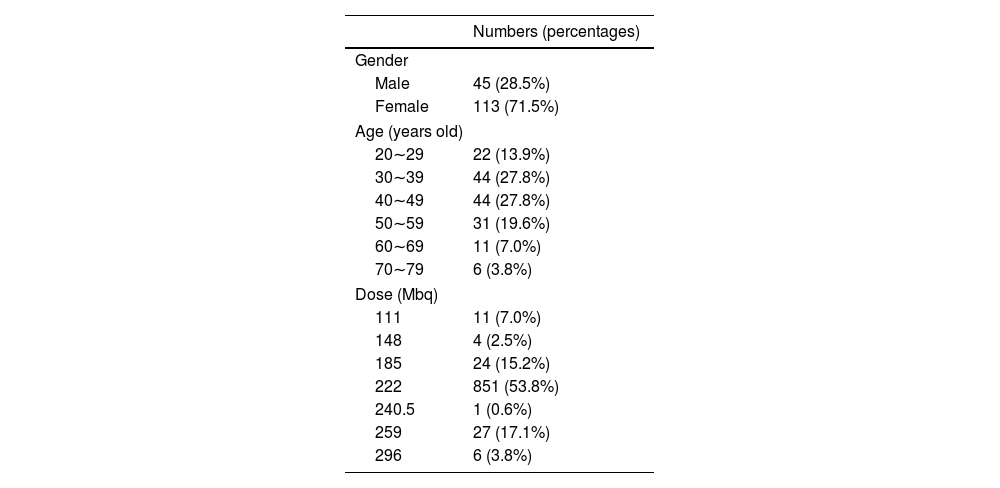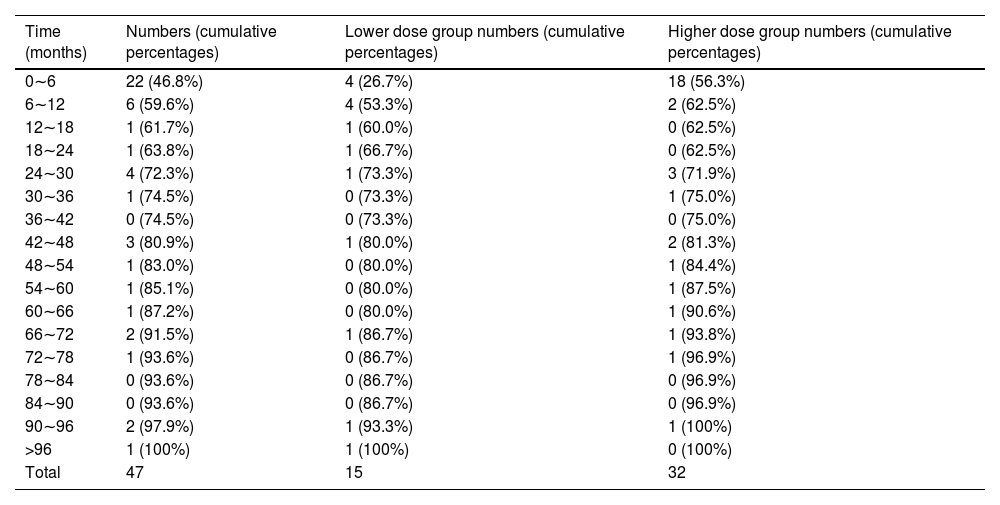The study aimed to analyze the outcome of low-dose radioactive iodine (RAI) treatment for hyperthyroidism, disclose whether age and gender influence the outcome and determine the incidence and onset time of hypothyroidism following low-dose RAI.
Material and methodsA total of 158 patients who received doses less than 370 Mbq RAI were enrolled in the study. Treatment outcome and incidence of hypothyroidism were compared between different gender (45 male vs.113 female), age (77 patients ≥45 years old vs. 81 patients <45 years old) and dose (39 patients receiving higher doses RAI vs. 119 receiving lower dose with a cutoff of 222 MBq) groups. Treatment outcomes were categorized into post-treatment hypothyroidism, treatment failure (persistent hyperthyroidism), and euthyroidism. In those becoming hypothyroid, time to develop hypothyroidism was calculated for cumulative incidences over time.
ResultsOut of 158 patients, 47 (29.7%) developed hypothyroidism, 101 (63.9%) had treatment failure, and 10 (6.3%) remained euthyroid after treatment. Response rates (33.6% vs. 43.5%, p = 0.260) and hypothyroidism incidences (26.9% vs. 38.5%, p = 0.170) did not differ significantly between lower and higher dose groups, neither between lower and higher age groups (p = 0.69 in response rates and p = 0.75 in hypothyroidism incidence). Females exhibited higher response rates (42.5% vs. 20.0%, p = 0.008) and hypothyroidism incidence (46.3% vs. 13.3%, p = 0.004) compared to males. Hypothyroidism onset occurred at a mean of 24.0 ± 29.2 months, and the cumulative incidences over time were 47% and 60% in six and twelve months, respectively.
ConclusionsLow-dose RAI has a low response rate for treating hyperthyroidism. Although there may be a lower incidence of hypothyroidism following low-dose RAI compared to high-dose RAI, hypothyroidism may occur early after treatment. Besides, females have higher response rates but more incidence of hypothyroidism. The balance between the risks and benefits of using low-dose RAI should be taken into deliberate consideration.
El estudio tuvo como objetivo analizar el resultado del tratamiento con yodo radioactivo de baja dosis (RAI) para el hipertiroidismo, revelar si la edad y el género influyen en el resultado, y determinar la incidencia y el tiempo de inicio del hipotiroidismo después del RAI de baja dosis.
Material y métodosUn total de 158 pacientes que recibieron dosis menores de 370 Mbq de RAI fueron incluidos en el estudio. Los resultados del tratamiento y la incidencia de hipotiroidismo se compararon entre diferentes grupos de género (45 hombres vs. 113 mujeres), edad (77 pacientes ≥45 años vs. 81 pacientes <45 años) y dosis (39 pacientes que recibieron dosis más altas de RAI vs. 119 que recibieron dosis más bajas con un límite de 222 MBq). Los resultados del tratamiento se categorizaron en hipotiroidismo post-tratamiento, fracaso del tratamiento (hipertiroidismo persistente) y eutiroidismo. En aquellos que desarrollaron hipotiroidismo, se calculó el tiempo para desarrollar hipotiroidismo para las incidencias acumulativas a lo largo del tiempo.
ResultadosDe los 158 pacientes, 47 (29.7%) desarrollaron hipotiroidismo, 101 (63.9%) tuvieron fracaso del tratamiento y 10 (6.3%) permanecieron eutiroideos después del tratamiento. Las tasas de respuesta (33.6% vs. 43.5%, p = 0.260) y las incidencias de hipotiroidismo (26.9% vs. 38.5%, p = 0.170) no difirieron significativamente entre los grupos de dosis más baja y más alta, ni entre los grupos de edad más baja y más alta (p = 0.69 en tasas de respuesta y p = 0.75 en incidencia de hipotiroidismo). Las mujeres exhibieron tasas de respuesta más altas (42.5% vs. 20.0%, p = 0.008) e incidencia de hipotiroidismo (46.3% vs. 13.3%, p = 0.004) en comparación con los hombres. El inicio del hipotiroidismo ocurrió a una media de 24.0 ± 29.2 meses, y las incidencias acumulativas a lo largo del tiempo fueron del 47% y 60% a los seis y doce meses, respectivamente.
ConclusionesEl RAI de baja dosis tiene una baja tasa de respuesta para tratar el hipertiroidismo. Aunque puede haber una menor incidencia de hipotiroidismo después del RAI de baja dosis en comparación con el RAI de alta dosis, el hipotiroidismo puede ocurrir tempranamente después del tratamiento. Además, las mujeres tienen tasas de respuesta más altas pero mayor incidencia de hipotiroidismo. El equilibrio entre los riesgos y beneficios de utilizar RAI de baja dosis debe ser considerado cuidadosamente.
Article

Revista Española de Medicina Nuclear e Imagen Molecular (English Edition)









